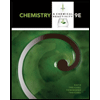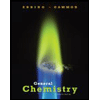
Mastering Chemistry with Pearson eText -- Standalone Access Card -- for Introductory Chemistry (6th Edition)
6th Edition
ISBN: 9780134565927
Author: Nivaldo J. Tro
Publisher: PEARSON
expand_more
expand_more
format_list_bulleted
Concept explainers
Textbook Question
Chapter 8, Problem 77E
Consider the reaction:
2N2(g)+5O2(g)+2H2O(g)→4HNO3(g)
If a reaction mixture contains 28g of N2, 150g of O2, and 36 g of H2O, what is the limiting reactant? (Try to do this problem in your head without any written calculations.)
Expert Solution & Answer
Trending nowThis is a popular solution!

Students have asked these similar questions
The Davies equation corrects the Debye-Hückel limiting law for calculating the
activity coefficient of an electrolyte in solution at relatively high concentrations.
Mathematically, it is expressed as: log y₁ = -Az²?
1 + √Ĩ
- 0,31)
Is the formula correct?
Differentiate between the concepts of "ionic salt effect" and "kinetic salt effect."
Differentiate the concepts of “salino effect” and “salino kinetic effect”.
Chapter 8 Solutions
Mastering Chemistry with Pearson eText -- Standalone Access Card -- for Introductory Chemistry (6th Edition)
Ch. 8 - Q1. Sulfur and fluorine react to form sulfur...Ch. 8 - Hydrogen chloride gas and oxygen gas react to form...Ch. 8 - Sodium reacts with fluorine to form sodium...Ch. 8 - Consider the hypothetical reaction shown here. If...Ch. 8 - Prob. 5SAQCh. 8 - Prob. 6SAQCh. 8 - Sodium and chlorine react to form sodium chloride....Ch. 8 - A reaction has a theoretical yield of 22.8 g. when...Ch. 8 - Titanium can be obtained from its oxide by the...Ch. 8 - Which statement best describes an exothermic...
Ch. 8 - Consider the generic reaction: A+2BAB2Hrxn=155kJ...Ch. 8 - Q12. Hydrogen gas reacts with oxygen to form...Ch. 8 - Prob. 1ECh. 8 - Nitrogen and hydrogen can react to from ammonia:...Ch. 8 - 3. Write the conversion factor that you would use...Ch. 8 - 4. What is wrong with this statement in reference...Ch. 8 - 5 what is the general from of the solution map...Ch. 8 - 6. Consider the recipe for making tomato and...Ch. 8 - 7 In a chemical reaction, what is the limiting...Ch. 8 - Prob. 8ECh. 8 - In a chemical reaction, what are the actual yield...Ch. 8 - If you are given a chemical equation and specific...Ch. 8 - 11. Consider the generic chemical...Ch. 8 - Prob. 12ECh. 8 - What is the enthalpy of reaction (Hrxn)? Why is...Ch. 8 - Explain the relationship between the sign of Hrxn...Ch. 8 - Consider the generic chemical reaction: A+2BC How...Ch. 8 - Consider the generic chemical reaction: 2A+3B3C...Ch. 8 - 17. For the reaction shown, calculate how many...Ch. 8 - 18. For the reaction shown, calculate how many...Ch. 8 - 19. Dihydrogen monosulfide reacts with sulfur...Ch. 8 - 20. Chlorine gas reacts with fluorine gas...Ch. 8 - For each reaction, calculate how many moles of...Ch. 8 - 22. For each reaction, calculate how many moles of...Ch. 8 - 23. For the reaction shown, calculate how many...Ch. 8 - 24. For the reaction shown, calculate how many...Ch. 8 - Consider the balanced equation:...Ch. 8 - 26. Consider the balance equation:
Complete the...Ch. 8 - 27. Consider the unbalanced equation for the...Ch. 8 - 28. Consider the unbalanced equation for the...Ch. 8 - 29. Consider the unbalanced equation for the...Ch. 8 - 30. Consider the unbalanced equation for the...Ch. 8 - Prob. 31ECh. 8 - 32. For the reaction shown, calculate how many...Ch. 8 - For each of the reactions, calculate how many...Ch. 8 - 34. For each of the reactions, calculate how many...Ch. 8 - 35. For the reaction shown, calculate how many...Ch. 8 - 36. For the reaction shown, calculate how many...Ch. 8 - Prob. 37ECh. 8 - Consider the balanced equation for the combustion...Ch. 8 - 39. For each acid–base reaction, calculate how...Ch. 8 - 40. For each precipitation reaction, calculate how...Ch. 8 - Sulfuric acid can dissolve aluminum metal...Ch. 8 - Hydrochloric acid can dissolve solid iron...Ch. 8 - 43. Consider the generic chemical equation:
a....Ch. 8 - Prob. 44ECh. 8 - Prob. 45ECh. 8 - Prob. 46ECh. 8 - For the reaction shown, find the limiting reactant...Ch. 8 - For the reaction shown, find the limiting reactant...Ch. 8 - 49. For the reaction shown, calculate the...Ch. 8 - For the reaction shown, calculate the theoretical...Ch. 8 - Consider the generic reaction between reactants A...Ch. 8 - Consider the reaction between reactants S and O2:...Ch. 8 - Consider the reaction 4HCI(g)+O2(g)2H2O(g)+2Cl2(g)...Ch. 8 - 54. Consider the reaction
Each molecular diagram...Ch. 8 - 55. For the reaction shown, find the limiting...Ch. 8 - For the reaction shown, find the limiting reactant...Ch. 8 - For the reaction shown, calculate the theoretical...Ch. 8 - For the reaction shown, calculate the theoretical...Ch. 8 - 58. If the theoretical yield of a reaction is 24.8...Ch. 8 - If the theoretical yield of reaction is 0.118 g...Ch. 8 - 61. Consider the reaction between calcium oxide...Ch. 8 - Consider the reaction between sulfur trioxide and...Ch. 8 - Consider the reaction between NiS2 and O2:...Ch. 8 - Consider the reaction between HCI and O2...Ch. 8 - Lead ions can be precipitate form solution with...Ch. 8 -
Ch. 8 - Consider the reaction between TiO2 and C:...Ch. 8 - 68. Consider the raction between N2H4 and N2O4:
A...Ch. 8 - 69. Classify each process as exothermic or...Ch. 8 - 70. Classify each process as exothermic or...Ch. 8 - Consider the generic reaction: A+2BCHrxn=55kJ...Ch. 8 - Prob. 72ECh. 8 - Consider the equation for the combustion of...Ch. 8 - The equation for the combustion of CH4 (the main...Ch. 8 - 75. Octane (C8H18) is a component of gasoline that...Ch. 8 - 76. The evaporation of water is...Ch. 8 - Consider the reaction:...Ch. 8 - Prob. 78ECh. 8 - A solution contains an unknown mass of dissolved...Ch. 8 - 80. A solution contains an unknown mass of...Ch. 8 - 81. Sodium bicarbonate is often used as an antacid...Ch. 8 - Toilet bowl cleaners often contain hydrochloric...Ch. 8 - 83. The combustion of gasoline produces carbon...Ch. 8 - Many home barbecues are fueled with propane gas...Ch. 8 - Prob. 85ECh. 8 - 86. Magnesium ions can be precipitated from...Ch. 8 - Hydrogen gas can be prepared in the laboratory by...Ch. 8 - Sodium peroxide (Na2O2) reacts with water to form...Ch. 8 - Prob. 89ECh. 8 - Pure oxygen gas can be prepared in the laboratory...Ch. 8 - 91. Aspirin can be made in the laboratory by...Ch. 8 - 92. The combustion of liquid ethanol produces...Ch. 8 - Urea (CH4N2 O), a common fertilizer, can be...Ch. 8 - 94. Silicon, which occurs in nature as SiO2, is...Ch. 8 - 95. The ingestion of lead from food, water, or...Ch. 8 - Prob. 96ECh. 8 - The propane fuel (C3H8) used in gas barbecues...Ch. 8 - Charcoal is primarily carbon. Determine the mass...Ch. 8 - 99. A loud classroom demonstration involves...Ch. 8 - 100. A hydrochloric acid solution will neutralize...Ch. 8 - 101. Scientists have grown progressively more...Ch. 8 - Prob. 102ECh. 8 - What volume of air is needed to burn an entire...Ch. 8 - Have each member of your group choose a...Ch. 8 - 105. Consider the combustion of propane:
a....
Knowledge Booster
Learn more about
Need a deep-dive on the concept behind this application? Look no further. Learn more about this topic, chemistry and related others by exploring similar questions and additional content below.Similar questions
- Come and compare the Bronsted-Bjerrum calculation, the Debye and Hückel calculation, and the Davies calculation.arrow_forwardplz watch the youtube video (the title of this topic) by roxi H. she explains it step by step but i get the wrong answerarrow_forwardWriting the rate law implied by a simple mechanism To exit full screen, press and hold esc Suppose the decomposition of ozone proceeds by the following mechanism: step elementary reaction rate constant 1 →>> O3(9) O2(g) + O(g) k₁ 2 03(g) + O(g) → 202(g) k2 Suppose also k₁ »k2. That is, the first step is much faster than the second. Write the balanced chemical equation for the overall chemical reaction: Write the experimentally- observable rate law for the overall chemical reaction. ☐ rate = ☐ Note: your answer should not contain the concentrations of any intermediates. Express the rate constant k for the overall chemical reaction in terms of K1, K2, and (if necessary) the rate constants k-1 and K-2 for the reverse of the two elementary reactions in the mechanism. k = ☐ 000 18 ローロ Ar OOarrow_forward
- Deducing a rate law from the change in concentration over time To exit full screen, press and hold esc A chemistry graduate student is studying the rate of this reaction: H2CO3(aq) → H₂O(aq) +CO₂ (aq) - She fills a reaction vessel with H2CO3 and measures its concentration as the reaction proceeds: time (milliseconds) [H2CO3] 0 0.0500 M 10. 0.0266M 20. 0.0181 M 30. 0.0138M 40. 0.0111 M Use this data to answer the following questions. Write the rate law for this reaction. Calculate the value of the rate constant k. Round your answer to 2 significant digits. Also be sure your answer has the correct unit symbol. rate ☐ x10 k = Х 000 18 Ararrow_forwardWriting the rate law implied by a simple mechanism Suppose the formation of tert-butanol proceeds by the following mechanism: step elementary reaction 1 (CH3)3 CBr(aq) → (CH3)2 C* (aq) + Br (aq) 2 (CH3)2C (aq) + OH¯ (aq) → (CH3)2COH(aq) rate constant k₁ k₂ Suppose also k₁ »k2. That is, the first step is much faster than the second. Write the balanced chemical equation for the overall chemical reaction: Write the experimentally- observable rate law for the overall chemical reaction. Note: your answer should not contain the concentrations of any intermediates. rate = k ☐ Express the rate constant k for the overall chemical reaction in terms of K1, K2, and (if necessary) the rate constants k-1 and K-2 for the reverse of the two elementary reactions in the mechanism. k = ☐ □ ☑ G ? 00. 18 Ar Barrow_forwardDeducing a rate law from the change in concentration over time A chemistry graduate student is studying the rate of this reaction: 2SO3 (g) →>> 2SO2 (g) + O2(g) He fills a reaction vessel with SO3 and measures its concentration as the reaction proceeds: ? time (minutes) [SO3] 0 0.0200M 1.0 0.0105 M 2.0 0.00552M 3.0 0.00290M 4.0 0.00152M Use this data to answer the following questions. Write the rate law for this reaction. rate = k ☐ x10 Calculate the value of the rate constant k. Round your answer to 2 significant digits. Also be sure your answer has the correct unit symbol. k = ☐ Х 000 18 Ar BAarrow_forward
- Using the Arrhenius equation to calculate k at one temperature from k at... The rate constant of a certain reaction is known to obey the Arrhenius equation, and to have an activation energy E reaction is 1.2 × 107 M −1 .S at 160.0 °C, what will the rate constant be at 194.0 °C? Round your answer to 2 significant digits. k = Шм −1 -1 .S ☐ x10 ☑ 5 = = 16.0 kJ/mol. If the rate constant of this a ? olo Ar Barrow_forwardUsing the Arrhenius equation to calculate k at one temperature from k at... a The rate constant of a certain reaction is known to obey the Arrhenius equation, and to have an activation energy E = 10.0 kJ/mol. If the rate constant of this reaction is 9.9 × 107 M -1 .S at 246.0 °C, what will the rate constant be at 196.0 °C? Round your answer to 2 significant digits. k = ☐ M -1 −1 .S x10 ☑ ? 00. 18 Ar Barrow_forwardWriting the rate law implied by a simple mechanism Suppose the reaction between nitric oxide and bromine proceeds by the following mechanism: elementary reaction - NO(g) + Br2(g) → NOBг2(g) step 1 2 NOBг2(g) + NO(g) - rate constant k₁ 2 NOBr(g) k2 Suppose also k₁ »k2. That is, the first step is much faster than the second. Write the balanced chemical equation for the overall chemical reaction: Write the experimentally- observable rate law for the overall chemical reaction. Note: your answer should not contain the concentrations of any intermediates. ☐ rate = k Express the rate constant k for the overall chemical reaction in terms of k₁, k2, and (if necessary) the rate constants k-1 and K-2 for the reverse of the two elementary reactions in the mechanism. = ☐ ロ→ロ Х ك ? 000 18 Ararrow_forward
- Deducing a rate law from the change in concentration over time chemistry graduate student is studying the rate of this reaction: 2H3PO4 (aq) → P₂O5 (aq) +3H₂O (aq) 2 e fills a reaction vessel with H3PO and measures its concentration as the reaction proceeds: 4 time (seconds) [H3PO4] 0 0.500M 1.0 0.229 M 2.0 0.148M 3.0 0.110M 4.0 0.0871 M se this data to answer the following questions. Write the rate law for this reaction. rate = k x10 Calculate the value of the rate constant k. k = Round your answer to 2 significant digits. Also be sure your answer has the correct unit symbol. ☑ G olo 18 Ararrow_forwardWriting the rate law implied by a simple mechanism Suppose the formation of nitrosyl chloride proceeds by the following mechanism: elementary reaction step rate constant 1 NO(g) + Cl2(g) → NOC₁₂(g) k₁ 2 NOCl2(g) + NO(g) 2 NOCl(g) →>> k2 Suppose also k₁ »k. That is, the first step is much faster than the second. Write the balanced chemical equation for the overall chemical reaction: Write the experimentally- observable rate law for the overall chemical reaction. rate = k ☐ Note: your answer should not contain the concentrations of any intermediates. Express the rate constant k for the overall chemical reaction in terms of K1, K2, and (if necessary) the rate constants k-1 and K-2 for the reverse of the two elementary reactions in the mechanism. k = | Х ? 18 Ararrow_forwardUsing first- and second-order integrated rate laws 1/5 Consider this reaction: H2CO3(aq) → H₂O (aq) +CO₂ (aq) At a certain temperature it obeys this rate law. rate = (2.27 s¹) [H2CO3] Suppose a vessel contains H2CO3 at a concentration of 0.830M. Calculate how long it takes for the concentration of H2CO3 to decrease by 83.0%. You may assume no other reaction is important. Round your answer to 2 significant digits. S x10 ☑ § ? 00. 18 Ararrow_forward
arrow_back_ios
SEE MORE QUESTIONS
arrow_forward_ios
Recommended textbooks for you
 Chemistry for Engineering StudentsChemistryISBN:9781337398909Author:Lawrence S. Brown, Tom HolmePublisher:Cengage Learning
Chemistry for Engineering StudentsChemistryISBN:9781337398909Author:Lawrence S. Brown, Tom HolmePublisher:Cengage Learning Chemistry & Chemical ReactivityChemistryISBN:9781133949640Author:John C. Kotz, Paul M. Treichel, John Townsend, David TreichelPublisher:Cengage Learning
Chemistry & Chemical ReactivityChemistryISBN:9781133949640Author:John C. Kotz, Paul M. Treichel, John Townsend, David TreichelPublisher:Cengage Learning General, Organic, and Biological ChemistryChemistryISBN:9781285853918Author:H. Stephen StokerPublisher:Cengage Learning
General, Organic, and Biological ChemistryChemistryISBN:9781285853918Author:H. Stephen StokerPublisher:Cengage Learning Chemistry: The Molecular ScienceChemistryISBN:9781285199047Author:John W. Moore, Conrad L. StanitskiPublisher:Cengage Learning
Chemistry: The Molecular ScienceChemistryISBN:9781285199047Author:John W. Moore, Conrad L. StanitskiPublisher:Cengage Learning ChemistryChemistryISBN:9781305957404Author:Steven S. Zumdahl, Susan A. Zumdahl, Donald J. DeCostePublisher:Cengage Learning
ChemistryChemistryISBN:9781305957404Author:Steven S. Zumdahl, Susan A. Zumdahl, Donald J. DeCostePublisher:Cengage Learning General Chemistry - Standalone book (MindTap Cour...ChemistryISBN:9781305580343Author:Steven D. Gammon, Ebbing, Darrell Ebbing, Steven D., Darrell; Gammon, Darrell Ebbing; Steven D. Gammon, Darrell D.; Gammon, Ebbing; Steven D. Gammon; DarrellPublisher:Cengage Learning
General Chemistry - Standalone book (MindTap Cour...ChemistryISBN:9781305580343Author:Steven D. Gammon, Ebbing, Darrell Ebbing, Steven D., Darrell; Gammon, Darrell Ebbing; Steven D. Gammon, Darrell D.; Gammon, Ebbing; Steven D. Gammon; DarrellPublisher:Cengage Learning

Chemistry for Engineering Students
Chemistry
ISBN:9781337398909
Author:Lawrence S. Brown, Tom Holme
Publisher:Cengage Learning

Chemistry & Chemical Reactivity
Chemistry
ISBN:9781133949640
Author:John C. Kotz, Paul M. Treichel, John Townsend, David Treichel
Publisher:Cengage Learning

General, Organic, and Biological Chemistry
Chemistry
ISBN:9781285853918
Author:H. Stephen Stoker
Publisher:Cengage Learning

Chemistry: The Molecular Science
Chemistry
ISBN:9781285199047
Author:John W. Moore, Conrad L. Stanitski
Publisher:Cengage Learning

Chemistry
Chemistry
ISBN:9781305957404
Author:Steven S. Zumdahl, Susan A. Zumdahl, Donald J. DeCoste
Publisher:Cengage Learning

General Chemistry - Standalone book (MindTap Cour...
Chemistry
ISBN:9781305580343
Author:Steven D. Gammon, Ebbing, Darrell Ebbing, Steven D., Darrell; Gammon, Darrell Ebbing; Steven D. Gammon, Darrell D.; Gammon, Ebbing; Steven D. Gammon; Darrell
Publisher:Cengage Learning
Bonding (Ionic, Covalent & Metallic) - GCSE Chemistry; Author: Science Shorts;https://www.youtube.com/watch?v=p9MA6Od-zBA;License: Standard YouTube License, CC-BY
Stoichiometry - Chemistry for Massive Creatures: Crash Course Chemistry #6; Author: Crash Course;https://www.youtube.com/watch?v=UL1jmJaUkaQ;License: Standard YouTube License, CC-BY